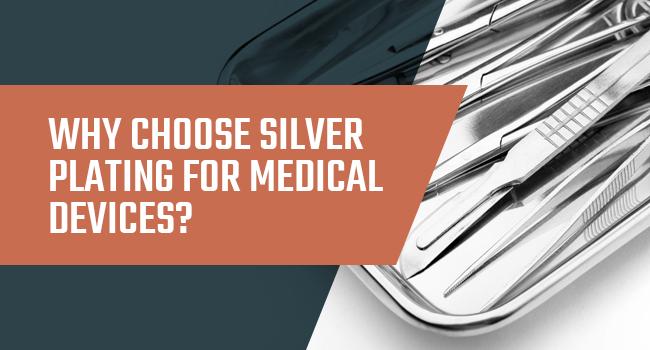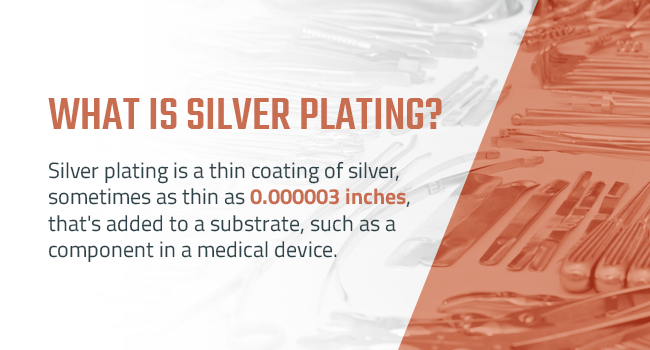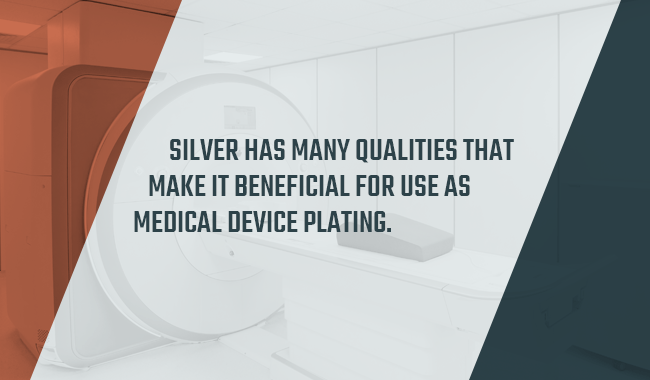
Silver is one of the most common metals used for plating in the medical industry. This precious metal offers numerous qualities that make it ideal for a range of medical device coating applications.
What Is Silver Plating?
Silver plating is a thin coating of silver, sometimes as thin as 0.000003 inches, that’s added to a substrate, such as a component in a medical device. Although the layer of metal is thin, it can provide various qualities to make a product last longer or make it more effective as well as perform other roles.
You can plate many different kinds of metals, but silver is one of the most common types of metal used in this way. Many different industries frequently use silver plating — including the automotive, electronics, telecommunications, and healthcare sectors.
There are numerous techniques you can use to plate silver onto a substrate. Before you can begin plating, however, you need to complete several preparatory steps.
First, it’s crucial that you ensure the parts you plan to use do not have any pits, cracks, tool marks, hydrogen embrittlement, excessive tensile stress, or unintended metal or non-metal inclusions. If you do not take care of these issues, they can cause problems with the quality of the plating, including poor adhesion or missing plating coverage in some areas. These problems could have even more severe impacts if you don’t catch them before sending the part to the customer.
It’s essential that you complete all necessary thermal and mechanical treatments, such as forming, bending, welding, soldering, machining, or heat treatments, before beginning the electroplating process. Often, the manufacturer will plate a layer of copper, nickel, or both before applying the silver plating. You may also wish to employ a silver strike or an anti-tarnish coating before plating the silver onto the substrate.
The next step is the actual plating process, of which there are several variants.
Electroplating involves immersing the substrate — the item to be plated — in an electrolytic solution that contains ions of the desired metal coating. While the substrate is submerged, you introduce an electrical current that causes the ions to deposit onto the substrate. The specifics of the process will vary depending on the desired coating, the type of substrate and the intended results.
Three of the most common silver electroplating methods for medical device manufacturing include reel-to-reel plating, rack plating, and barrel plating:
1. Barrel Plating
Barrel electroplating involves placing the substrates in a barrel-shaped cage that has bars stretching through it that conduct an electrical current. You submerge this barrel in a tank that contains the electrolytic solution, where it undergoes a tumbling action. The components in the barrel should establish a bipolar contact with each other to increase the efficiency of the plating process.
This technique is ideal for quickly and economically plating multiple smaller items at once, and it results in a complete and uniform coating. It’s not as precise as some other methods and isn’t the best option for components that are large, fragile, or complex.
2. Rack Plating
Rack plating is another common electroplating method. It involves attaching the substrate to a rack using hooks, screws, or other items before submerging the rack in the electroplating solution. The hooks or screws conduct the electrical current that deposits the ions onto the substrate.
Rack plating is perfect for working with components that are larger, more complex, or too delicate for barrel plating. At SPC, we build our own electroplating racks, which enables us to meet the precise requirements of various projects.
Some of the challenges of rack plating include ensuring that the deposit is uniform and the fact that discoloration may occur where the substrate touches the rack.
3. Reel-to-Reel Plating
Reel-to-reel plating, also called continuous electroplating, is another method of applying silver plating. Using this method, we can apply silver plating to reels of raw materials before they are machined into parts or apply plating to strips of manufactured parts.
This method involves loading the reels of material onto de-reeling equipment, which feeds them through the electroplating process. A take-up system then re-reels the finished plated material. Reel-to-reel plating allows you to either coat an entire substrate or define only specific parts to be plated.
Benefits of Silver Plating for Medical Devices
Silver has many qualities that make it beneficial for use as medical device plating. Some of the primary benefits include:
1. Cost-effectiveness
Silver is more cost-effective than many other similar metals. It is the least expensive precious metal and using it instead of gold or palladium can reduce your costs substantially. In electrical conductor applications, it can also significantly decrease wasteful power usage as well as increase the battery life of wearable medical devices.
2. Biocompatibility
To be used for medical devices, materials need to be biocompatible — that is, able to come into contact with the human body without causing an adverse reaction. Some metals will release ions in the body or cause allergic reactions after prolonged contact with human tissue. Silver, though, is biocompatible. It is useful for coating materials that might otherwise cause an adverse reaction.
3. Antimicrobial and Antibacterial Qualities
Silver has characteristics that make it resistant to microbes and bacteria that may be harmful to the human body. Silver does not allow for bacterial growth and even targets components within bacteria cells so that they do not become resistant to silver. Such antimicrobial and antibacterial qualities are critical for ensuring that medical devices are safe to use.
4. High Electrical Conductivity
Silver is prized for its excellent electrical conductivity. This property makes it ideal for use in electrically powered medical devices and electrosurgical tools. Even if silver tarnishes, it still retains the same electrical conductivity.
5. High Thermal Conductivity
Silver is also highly thermally conductive, which is critical to the functioning of electrosurgical instruments.
6. High Light Reflectivity
Light reflectance is another valuable property that silver possesses. It is the metal with the highest degree of optical reflectivity within the visible range, making it useful for medical lasers.
7. Low Weight
Silver also has the lowest weight of any metal in the precious metals group. This helps make medical devices such as wearables less cumbersome. This quality is also useful when manufacturing micro-components.
8. Corrosion Resistance
Silver has excellent resistance to corrosion, which helps products last longer. A silver coating may be used to protect the substrate material from corrosion. Although silver can tarnish, this is mostly just an aesthetic concern.
9. Manufacturability
Silver is relatively easy to manufacture. It is ductile, easy to metalize onto nearly any material, and readily alloys with other metals. It has excellent solderability as well as thermo-compression bonding and wire-bonding abilities.
10. Creates a Lubricious Surface
Silver plating can help make a surface more lubricious, which is beneficial for devices with moving parts. It forms a coating for anti-seizing and anti-galling in applications involving high-temperature nuts, gaskets, bearings, and metal shims.
Common Applications for Silver Plating in Medical Devices
The numerous beneficial qualities of silver plating make it useful for many different applications in the medical field. Here are some of those applications.
1. Electrical Components in Medical Devices
Many of the medical devices and pieces of medical equipment that have electrical components use silver plating to enhance electrical conductivity and resistance to corrosion. These components can also use gold, but silver provides a lower-cost alternative.
Electrical components that may have metal plating include contact pins, battery contacts, connectors, switches, bus bars, springs, radio frequency (RF) coils, and RF amplifiers. A wide variety of medical equipment has electrical components that need plating, and different components require different plating specifications.
2. Wearable Medical Devices
Wearable medical devices such as insulin pumps, glucose monitors, heart monitors, infant monitors, pain management devices, and various medical diagnostic products utilize silver plating. It can enhance the electrical conductivity properties and increase battery life in many of these devices.
3. Handheld Electrosurgical Devices
Electrosurgical devices as well as energy-based therapy devices often incorporate silver plating because of its ability to enhance electrical and thermal conductivity.
Bipolar forceps, which use an electrical current to stop bleeding, are one such electrosurgical tool. Coating the tips of the bipolar forceps with silver can enhance their thermal conductivity and allow for low thermal spread, so as not to harm the tissue surrounding the site. Silver plating provides similar benefits when used for cautery pencils and other tools.
4. Scope and Imaging Devices
Silver plating can protect against the corrosion of endoscopic and arthroscopic tools as well as scanning devices. The plating enhances their antibacterial properties and helps them last longer.
5. Radio-Frequency Ablation Devices
RF ablation devices utilize radio frequency to generate heat at a precise temperature directed at an exact location. The non-surgical RF ablation of tumors can kill cancerous tissues while leaving other tissue unharmed.
This process involves a probe that is inserted into the unwanted tissue. Small electrodes located at the tip of the probe are sent into the tissue. This probe is often plated with silver or gold.
RF ablation also involves thermocouples, which are located in the ends of RF device electrodes. These devices monitor the temperature of the tissue so that the correct temperature can be reached by adjusting the power of the electrodes. Thermocouples can use gold or silver plating.
6. MRI Machines
Medical imaging equipment, such as magnetic resonance imaging (MRI) machines, often utilizes silver plating. These coatings help enhance the durability and reliability of these machines.
MRI machines include many components that can benefit from silver plating. They include a superconducting magnet made of wire coils and bitter plates. These components are often made from copper parts plated with silver. These components need to be able to withstand cooling to cryogenic temperatures. In their superconducting state, the plated parts can conduct stronger electrical currents than usual. When they transfer these strong currents, they create the magnetic fields needed for MRI scans.
7. Medical Lasers
Medical lasers, which can be used for wound cauterization, imaging, and many other applications, also often use silver plating. These devices include laser scalpels, laser skin resurfacing instruments, Lasik eye surgery equipment, and other kinds of devices.
Components within these devices that may use silver plating include optical waveguides, cooling blocks, and light barriers. Many of these tools benefit from the high reflectivity of silver coatings.
8. Catheters
Silver plating is also frequently a component in catheters. Electroplating onto the surface of medical catheter braids improves the connections between the braid intersections and makes it less likely that kinks will occur in the catheter. This enhances insertion accuracy and decreases patient discomfort.
Copper core mandrels plated with silver are used in catheter manufacturing. These mandrels allow manufacturers to improve catheter designs, prevent adhesion issues, and machine to precise dimensions. Silver plating on polymer substitutes may also be used for catheter components such as stents, catheter tips, and extruded tubing.
9. Device Housings
The housing that protects all sorts of medical devices, from stethoscopes to radiological devices, may also employ silver plating. It’s crucial that these metallic structures be durable enough to ensure the reliability of these instruments.
Requirements for Silver Plating
When silver-plated products are used for medical applications, they need to adhere to strict requirements to ensure quality and safety. The plating processes need to meet U.S. Food and Drug Administration (FDA) requirements and standards, including ASTM B700, AMS 2410;11;12, and MIL-QQ-S-365. Using processes that meet these standards helps ensure reliable, repeatable results. In turn, this improves product performance and patient safety.
You may also wish to obtain validation of medical device coatings to ensure that they meet all applicable requirements. There are three main types of validation:
- Installation Qualification (IQ): IQ provides evidence that the installation of the equipment used for the plating process complies with manufacturers’ specifications and recommendations. This verification provides assurance that the equipment is installed correctly in the facility.
- Operation Qualification (OQ): OQ provides evidence that the process will result in a product that meets all design requirements. It provides assurance that the process will maintain control limits and action limits that will produce parts that meet all necessary specifications.
- Performance Qualification (PQ): PQ provides evidence that the process will result in a product that will perform as expected. The process needs to produce results of a consistent quality across numerous production runs and operators. Consistent performance is especially crucial for medical devices.
Why Plate With SPC?
SPC provides silver plating services that meet all requirements and specifications and result in consistently high-quality products. Our engineers can help you determine the right kinds of coating and plating processes for your needs. Because we build the majority of our equipment, we’re able to meet custom specifications easily. We can provide you with a plating solution that’s cost-effective without sacrificing quality.
To get started, contact us today or fill out this form for a free, no-obligation quote. Discover the SPC difference today.







